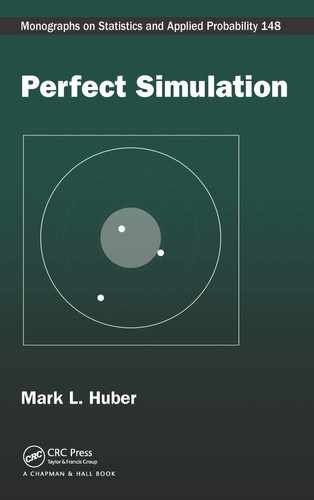224 BIBLIOGRAPHY
[88] B. Mat´ern. Spatial Variation, Lecture Notes in Statistics, 2nd edition,vol-
ume 36. Springer-Verlag, New York, 1986.
[89] M. Matsumoto and T. Nishimura. Mersenne twister: a 623-dimensionally
equidistributed uniform psuedo-random number generator. ACM Transactions
on Modeling and Computer Simulation, 8(1):3–30, 1998.
[90] D. Mattson. On perfect simulation of Markovian Queuing Networks with
Blocking. PhD thesis, G¨oteborg University, 2002.
[91] N. Metropolis, A.W. Rosenbluth, M.N. Rosenbluth, A.H. Teller, and E. Teller.
Equation of state calculation by fast comp uting machines. J. Chem. Phys.,
21:1087–1092, 1953.
[92] J. R. Michael, W.R. Schucany, and R.W. Haas. Generating random variates
using transformations with multiple roots. Amer. Statist., 30:88–90, 1976.
[93] H. Minc. Upper bounds for permanents of (0,1)-matrices. Bull. Amer. Math.
Soc., 69:789–791, 1963.
[94] A. Mira, J. Møller, and G.O. Roberts. Perfect slice samplers. J. R. Statist. Soc.
Ser. B Stat. Methodol., 63:593–606, 2001.
[95] A. Mira and L. Tierney. On the use o f aux iliar y variables in Markov chain
Monte Carlo sampling. Scand. J. Stat., 29(1):1–12, 2002.
[96] J. Møller. Perfect simulation of conditionally specified models. J. R. Statist.
Soc. Ser. B Stat. Methodol., 61:251–264, 1999.
[97] J. Møller and K.K. Berthelsen. Transforming spatial point processes into Pois-
son processes u sing random superposition. Advances in Applied Probability,
44:42–62, 2012.
[98] J. Møller, M. L. Huber, and R. L. Wolpert. The stationary Mat´ern hard core
process of type III. Stochastic Process. Appl., 120:2142–2158, 2010.
[99] J. Møller and K. Mengersen. Ergodic averages for monotone functions us-
ing upper and lower dominating processes. In J.M. Bernardo, M.J. Bayarri,
J.O.Berger,A.P.Dawid,D.Heckerman,A.F.M.Smith,andM.West,edi-
tors, Bayesian Statistics 8, pages 643–648. Oxford University Press, Oxford,
2007.
[100] J. Møller and K. Mengersen. Ergodic averages via dominating processes.
Bayesian A nalysis, 2:761–782, 2007.
[101] J. Møller, A.N. Pettitt, R. Reeves, and K. K. Berthelsen. An efficient Markov
chain Monte Carlo method for distributions with intractable normalising con-
stants. Biometrika, 93(2):451–458, 2006.
[102] J. Møller and J. G. Rasmussen. Perfect simulation of Hawkes processes. Adv.
in Appl. Probab., 37:629–646, 2005.
[103] J. Møller and K. Schladitz. Extensions of Fill’s algorithm for perfect simula-
tion. J. R. Stat. Soc. B. Stat. Methodol., 61:955–969, 1999.
[104] J. Møller and R. P. Schoenberg. Thinning spatial point processes into Poisson
processes. Advances in Applied Probability, 42:347–358, 2010.
BIBLIOGRAPHY 225
[105] J. Møller and R. P. Waagepetersen. Statistical Inference and Simulation for
Spatial Point Processes. Chapman & Hall/CRC, 2004.
[106] J. Morton, L. Pachter, A. Shiu, B. Sturmfels, and O. Wienand. Convex rank
tests and semigraphoids. SIAM J. Discrete Math., 23(2):1117–1134, 2009.
[107] D. J. Murdoch and P. J. Green. Exact sampling from a continuous state space.
Scand. J. Statist., 25(3):483–502, 1998.
[108] I. Murray, Z. Ghahramani, and D. J. C. MacKay. MCMC for doubly-
intractable distributions. In Proc. of 22nd Conf. on Uncertainty in Artificial
Intelligence (UAI), 2006.
[109] E. Nummelin. General irreducible Markov chains and non-negative opera-
tors. Cambridge University Press, Cambridge, 1984.
[110] B.K. Øksendal. Stochastic Differential Equations: An Introduction with Ap-
plications. Springer-Verlag, Berlin, 1998.
[111] C.J. Preston. Spatial birth-and-death processes. Bull. Inst. Int. Stat.,
46(2):371–391, 1977.
[112] J. G. Propp and D. B. Wilson. Exact sampling with coupled Markov chains
and applications to statistical mechanics. Random Structures Algorithms,9(1–
2):223–252, 1996.
[113] A. Reutter and V. Johnson. General strategies for assessing convergence of
mcmc algorithms using coupled sample paths. Technical Report 95–25, Duke
University, 1995.
[114] R. Rivest. On self-organizing sequential search heuristics. Comm. of the ACM,
19:63–67, 1976.
[115] C. P. Robert and G. Casella. Monte Carlo Statistical Methods (2nd ed.).
Springer, New York, 2004.
[116] R. Sinkhorn. A relationship between arbitrary positive matrices and double
stochastic matrices. A. Math. Statist., 35:876–879, 1964.
[117] John Skilling. Nested Sampling for general Bayesian computation. Bayesian
Anal., 1(4):833–860, 2006.
[118] A. Sly and N. Sun. The computational hardness of counting in two-spin mod-
els on d-regular graphs. In Foundations of Computer Science (FOCS), pages
361–369, 2012.
[119] D. J. Strauss. A model for clustering. Biometrika, 63:467–475, 1975.
[120] Roy L. Streit. Poisson Point Processes: Imaging, Tracking, and Sensing.
Springer, New York, 2010.
[121] R. Swendsen and J-S. Wang. Replica Monte Carlo simulation of spin glasses.
Phys.Rev.Let., 57:2607–2609, 1986.
[122] Michael E. Taveirne, Casey M. Theriot, Jonathan Livny, and Victor J. DiRita.
The complete campylobacter jejuni transcriptome during colonization of a nat-
ural host determined by RNAseq. PLoS ONE, 8:e73586, 2013.
226 BIBLIOGRAPHY
[123] A. M. Turing. Computability and
λ
-definability. J. Symbolic Logic, 2(4):153–
163, 1937.
[124] L. G. Valiant. The complexity of computing the permanent. Theoret. Comput.
Sci., 8:189–201, 1979.
[125] J. P. Valleau and D. N. Card. Monte Carlo estimation o f the free energy by
multistage sampling. J. Chem. Phys., 57(12):5457–5462, 1972.
[126] J. van den Berg and C. Maes. Disagreement percolation in the study of Markov
fields. Ann. Probab., 22:749–763, 1994.
[127] J. von Neumann. Various techniques used in connection with random digits.
In Monte Carlo Method, National Bureau of Standards Applied Mathematics
Series 12, pages 36–38, Washington, D.C., 1951. U.S. Government Printing
Office.
[128] D. B. Wilson. Generating random spanning trees more quickly than the cover
time. In Proc. 28th ACM Sympos. on the Theory of Computing, pages 296–
303, 1996.
[129] D. B. Wilson. How to couple from the past using a read-once source of ran-
domness. Random Structures Algorithms, 16(1):85–113, 2000.
[130] D. B. Wilson. Layered multishift coupling for use in perfect sampling algo-
rithms (with a primer on cftp). Fields Institute Communications, 26:141–176,
2000.
..................Content has been hidden....................
You can't read the all page of ebook, please click here login for view all page.
